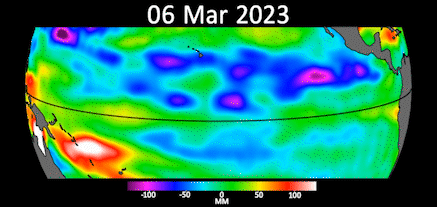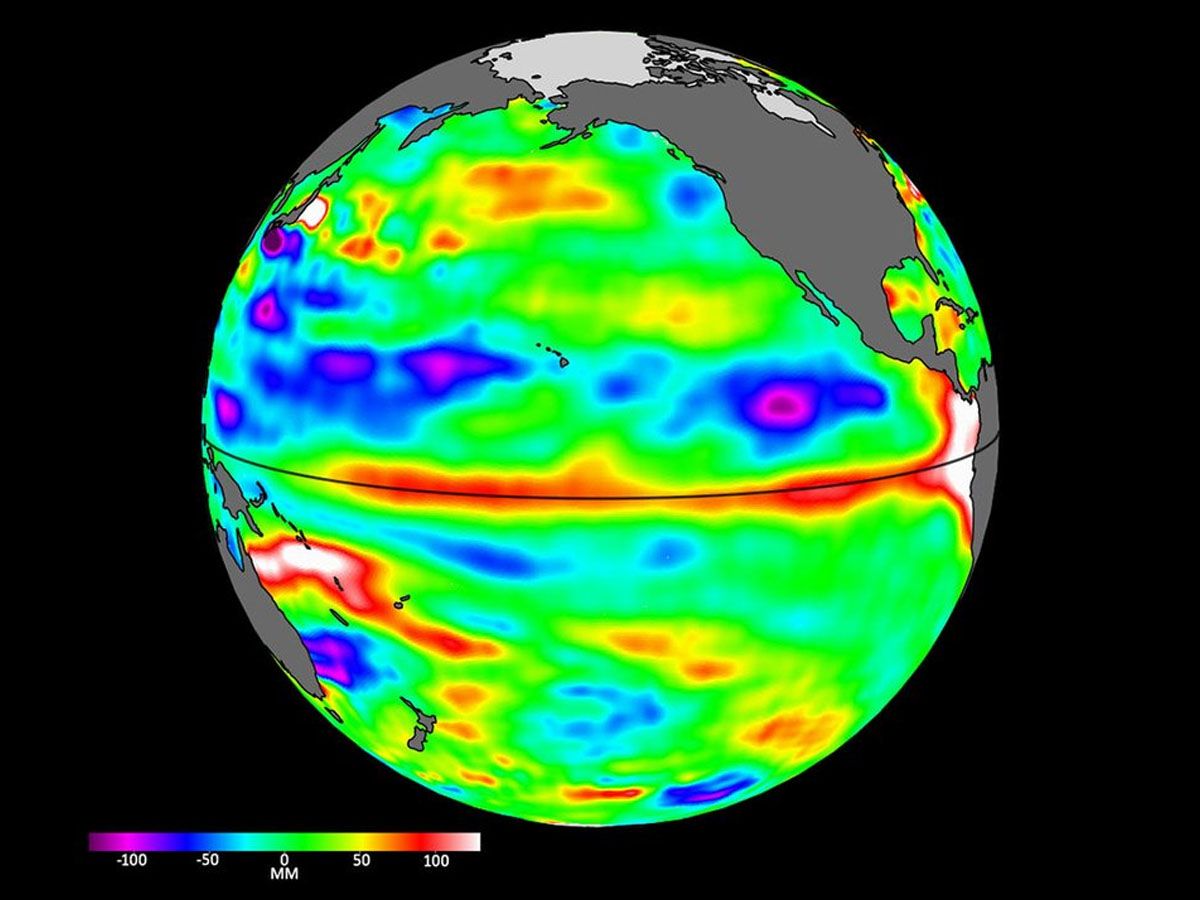Have you ever thought about how the seemingly serene Pacific Ocean can silently brew patterns that have the strength to trigger a cascade of global weather events? It's quite something, isn't it? Welcome to my exploration of the fascinating world of El Niño and La Niña, the powerful twins of climate patterns. These siblings are part of a larger clan known as the El Niño-Southern Oscillation (ENSO) cycle.
Far from ordinary scientific occurrences, their influences range from reshaping rainfall patterns across the globe, playing a role in wildfire seasons, impacting economies, and even determining the fate of diverse marine life. I'll take you on an intriguing journey, decoding these patterns, and diving into how modern marvels like the Sentinel-6 Michael Freilich satellite are revolutionizing our understanding and forecasting of these climate phenomena.
Decoding El Niño
What if I told you that the Pacific Ocean gets a bit of a fever every few years? This fever, known as El Niño, is a climate phenomenon defined by warmer-than-average sea surface temperatures in the central and eastern Pacific.
This event dates back centuries, and it's believed that South American fishermen in the 1600s were among the first to spot its cyclical nature, particularly noting its peak around December.
El Niño is far from a local event. Its feverish fingers reach out across the globe, rearranging weather patterns with far-reaching effects. It's known to weaken trade winds, setting in motion a series of climate dominoes.

One such domino is the shift of the Pacific jet stream southward, which generally results in dryer and warmer conditions in northern parts of the U.S. and Canada. Meanwhile, regions like the Gulf Coast and the Southeastern U.S. brace for increased rainfall and flooding.
However, it's not just the weather that El Niño impacts; it has significant implications for ecosystems and economies as well. Fluctuations in rainfall and temperature can impact agricultural yields, disrupt fishing industries, and even escalate the risk of wildfires.
The marine world is not left untouched either. As El Niño events weaken upwelling, the process that brings cold, nutrient-rich water to the surface, the decrease in nutrient availability can disrupt marine food chains. On the other hand, it can also introduce tropical species to typically colder regions, creating a strange, temporary shift in marine biodiversity.
The Other Side: La Niña
In Spanish, La Niña, meaning 'Little Girl', can be seen as El Niño's colder sister. This climate event, defined by cooler-than-average sea surface temperatures in the central and eastern Pacific, often follows in the wake of an El Niño. In many ways, its effects are the mirror image of El Niño's, underlining their status as the yin and yang of climate patterns.
During a La Niña event, the trade winds don't just return to their normal strength; they actually become stronger. This pushes warm surface water towards Asia, leaving cooler water in the eastern Pacific, which in turn promotes upwelling and leads to an increase in nutrient availability.

Just as with El Niño, the effects of La Niña extend far beyond the ocean. It pushes the Pacific jet stream northward, leading to potential drought conditions in the southern U.S. and heavy rainfall in the Pacific Northwest and Canada. Moreover, La Niña can contribute to a more severe hurricane season, emphasizing its influential role in global weather systems.
Marine life also sees a shift during La Niña conditions. The cold waters and increased nutrients attract species such as squid and salmon to the Pacific coast, demonstrating how these climatic oscillations can shape the geographic distribution of marine species.
The Role of NASA and the Sentinel-6 Michael Freilich Satellite
As we set our sights on the cosmos, spacecraft like the Sentinel-6 Michael Freilich is reshaping our abilities to surveil and forecast El Niño and La Niña episodes. This collaboration, drawing together the expertise of the European Space Agency (ESA), the European Organisation for the Exploitation of Meteorological Satellites (EUMETSAT), NASA, and the National Oceanic and Atmospheric Administration (NOAA), was designed with a mission to gather meticulous sea level data covering more than 90% of our world's oceans.
One fascinating aspect of Sentinel-6's monitoring process is the role of Kelvin waves. These massive undersea waves, moving eastward across the Pacific, are considered a precursor to El Niño. By detecting and tracking these waves, Sentinel-6 offers valuable insights that improve the reliability of El Niño predictions.
The Findings and Predictions for the Upcoming El Niño Event
Satellite data paint an evolving picture of our planet's climate health, and current observations suggest we're on the cusp of another El Niño event. The NOAA has released predictions indicating warmer sea surface temperatures in the Pacific within the next few months. This El Niño event is expected to influence weather patterns globally, potentially causing droughts in some areas and floods in others.
Understanding these predictions allows for preparation and response strategies, from conservation measures that protect threatened marine life to steps taken by agricultural sectors to mitigate potential losses. By scrutinizing the predictions and planning accordingly, we can help buffer the more vulnerable facets of our planet and societies from the ebbs and flows of El Niño and La Niña.
The Unseen Power of Kelvin Waves: The Harbingers of El Niño
Ever heard of Kelvin Waves? These are no ordinary waves. They are a type of atmospheric wave that plays a crucial role in our global climate, acting as catalysts for the El Niño phenomenon.
Their job? They transport warm upper-layer water from west to east across the equatorial Pacific Ocean. When they move, they create a ripple effect, leading to an increase in ocean temperatures. This shifting of warm water has far-reaching implications, as it is a precursor to El Niño events.

Recently, Kelvin waves have made their mark again. Observations point towards Kelvin waves moving eastward across the Pacific Ocean, a movement known as a forerunner of El Niño. This change can potentially signify the onset of another El Niño event, reinforcing the importance of these less-visible but impactful oceanic movements.
The Sentinel-6 Michael Freilich Satellite's Role in Tracking Kelvin Waves
The Sentinel-6 Michael Freilich Satellite, a wonder of modern technology, plays a critical role in tracking these silent climate influencers. Its state-of-the-art radar altimeter captures the height of the ocean surface, allowing scientists to track the movement and strength of Kelvin waves across the Pacific Ocean.

Recent satellite data has been revealing. The Sentinel-6 has detected higher and warmer ocean water at the equator and on the west coast of South America. This indicates Kelvin waves have been active, transporting warm water and higher sea levels off the coasts of Peru, Ecuador, and Colombia. This data forms part of a larger picture, helping us predict the potential for a new El Niño event.
Ecosystems and Economies Under the Influence of El Niño and La Niña
Beyond the weather, the ripples of El Niño and La Niña spread to affect ecosystems and economies worldwide. For marine life, El Niño often means a less hospitable environment, as the weakening of upwelling reduces nutrient availability. However, it also brings tropical species to typically colder regions.
La Niña, however, breathes life into the oceans, with colder waters and increased nutrients supporting an abundance of marine life. The climate pattern attracts species like squid and salmon to the Pacific coast. But there's a storm brewing, quite literally, as La Niña can amplify the hurricane season.
The economic implications of these climatic shifts are akin to walking on a tightrope. From the crops in our fields to the catch in our seas, even the roaring wildfires, and the complex global supply chains we rely on, all feel the effects of El Niño and La Niña.
The Sentinel-6 Michael Freilich Satellite, under NASA's watchful eye, plays a vital role from its position high above in space. Monitoring El Niño's intricate dance deepens our understanding of these phenomena and improves our ability to foresee their future impacts. This advanced insight is absolutely essential for navigating the waves of our collective global future.
Source: weather.com / nasa.gov / noaa.gov / livescience.com












